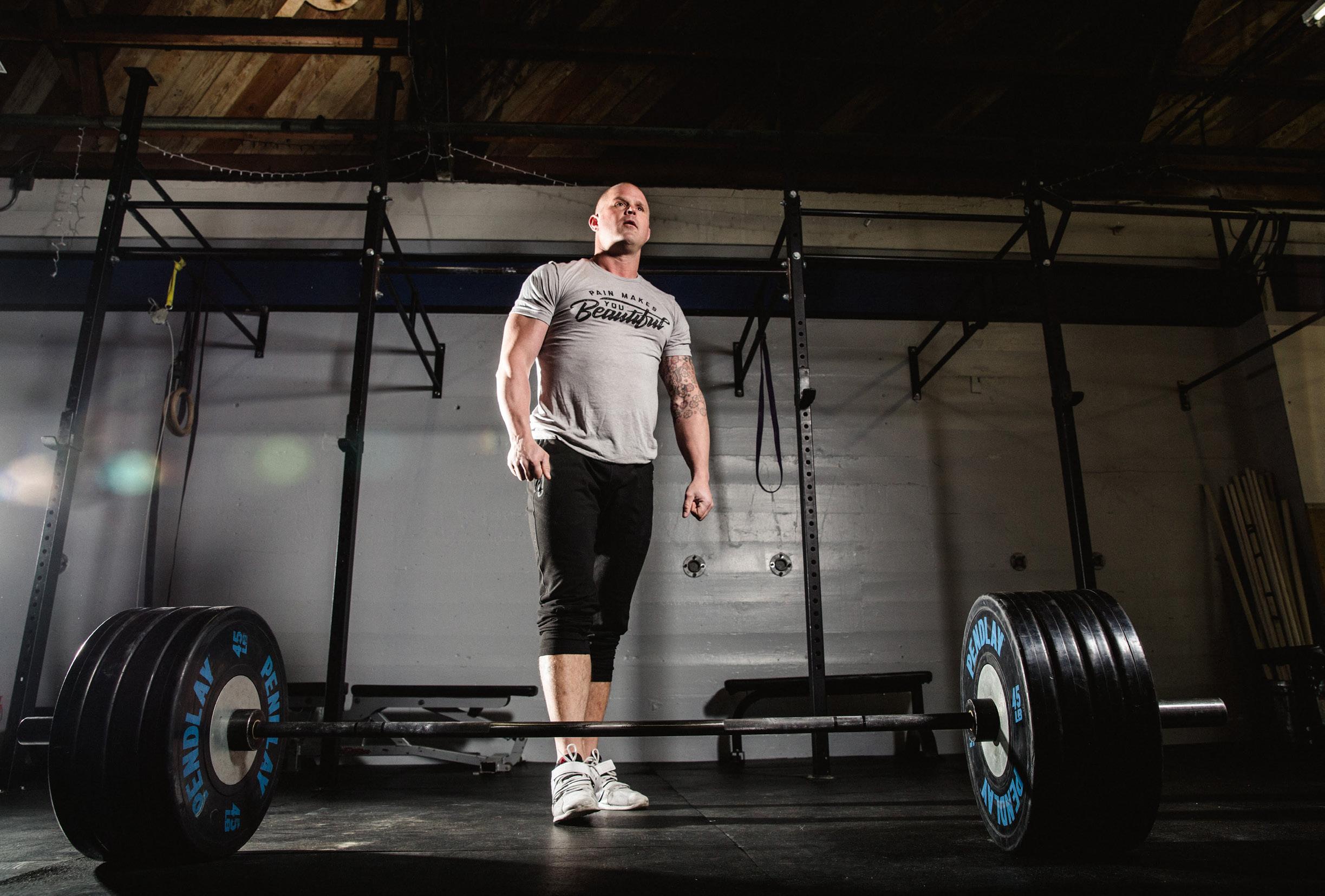
9 minute read
Four Horsemen of the Spine
Mobilize the back’s big movers
BY DR. KELLY STARRETT THE READY STATE Physical therapist, speaker, New York Times bestselling author of Becoming a Supple Leopard, living in San Francisco, CA. Watch for Kelly and Juliet Starrett’s new book release, Built to Move, on April 4, 2023.
THEREADYSTATE THEREADYSTATE
You’ve likely heard me talk about the four horsemen of the spine before. These are four big movers that, together, all support hip flexion or spinal extension. Now of course the body’s movement system is “slightly” more complex than just a few big muscles around the pelvis, but over the past few decades, we’ve discovered that these four muscles (and attendant connective tissues) can be a great place to start if you are experiencing low back pain or discomfort.
The first of the four horsemen is the rectus femoris. This long muscle in the quadriceps connects the kneecap all the way up to your pelvis. So, this is a knee-to-pelvis connector. It has a tendency to become stiff in a lot of people.
Next is the iliacus, coming from inside the pelvic bowl to the femur. This muscle sits deep inside the pelvic bowl and just doesn’t often get much love when it comes to mobility. Though hard to reach, it’s not impossible, and we’ll discuss some great ways to get in there.
The third is the psoas muscle, which connects the trunk to the femur and forms the iliopsoas system with the iliacus. The psoas crosses a lot of real estate and is a powerful hip flexor, or spine forward flexor, or spine extender. It also swells to keep the spine stable. I like to think of this amazing tissue as the quads of the low back.
Last but not least is quadratus lumborum (QL), which connects the bottom of your rib cage to the top of your pelvis in the lower back. As I often say to athletes during mobilizations, “The QL is not a bone! No matter how much it feels like one.” The QL actually shares a common attachment to the psoas and can be considered the hamstrings of the spine (yes this is over-simplified).
While all of these four tissues have incredibly diverse functions, they all can potentially create an extension load on the spine. This is one of the reasons why stiff quads can contribute to low back pain, for example. If you think about couch stretch for a second, that position loads the iliacus, psoas, and rectus femoris by challenging hip extension, or three out of the four horsemen. When we are able to relieve some of the passive extension forces on the spine, we often see significant improvements in spinal and hip function, and decreases in back pain.
ADDRESSING THE RECTUS FEMORIS
The rectus femoris is one of the four quad muscles, connecting your pelvis all the way through your patella. This tissue system can become especially fibrotic and jerky-like, and doesn’t typically respond as well to stretching. It’s hard to stretch jerky, but you can mobilize it.
To find the rectus femoris, we’re going to mobilize in the same position as the basic quad smash on a roller, starting just above the knee. • Lay down, belly facing the ground, and get your leg on that roller. • Roll across that patch of tissue, looking for anything that feels tight and fibrotic. If you find a tissue that clunks back and forth each time you roll across it, that’s the rectus femoris. We’re gonna go all the way up the quad, scrubbing across and focusing on that tissue. Don’t worry, the rest of the horsemen are less gnarly. • Take this mobilization, moving and scrubbing, from just above your knee to just under the bottom of the pelvis.
REACHING THE ILIACUS
The iliacus sits deep inside the pelvic bowl, making it one of the most difficult muscles to reach with stretching or tissue mashing. It is simultaneously a major player in creating stability for your trunk and torso, but can easily become the main contributor to immobility and pain. • We’re going after the iliacus by laying a ball (a large hardball, or even a kettlebell handle will do) just on the inside of our hip bone. • You can find this point by laying on the ball with the tip of your hip bone on either side and then just falling off it into the musculature on the inside of that pelvic bowl. • We want to breathe and sink into these tissues, tracing the pelvic bone down towards the femur. • Know that as you move towards your leg, you may run into the nerve and artery in your groin. You can stop when you feel it!
ROLLING-OUT THE PSOAS
Often people refer to the iliacus and psoas together as the iliopsoas, but these two muscles are different systems. The iliacus
Kelly Starrett is one of the world's top experts on mobility, movement and human performance.
connects the pelvis to the femur whereas the psoas connects the spine to the femur, so though they do similar things, they are quite different in terms of connections.
With a heavy ball, or a lacrosse ball, and a kettlebell for more pinpointed work, we can address the psoas while laying on our back instead of laying on top of the ball with our stomach. This lets us receive a different input and have access to hip flexion within the mobilization. • To go at the psoas this way, lie on your back, take a lacrosse ball, and press it into your gut about halfway between your belly button and your hip bone. • Then put a kettlebell on top of the ball and hold the bell handle to press the lacrosse ball into your psoas. From here you can floss the muscle by flexing and extending your leg, and internally and externally rotating the hip in combination with that. • Breathe into the mobilization and move the ball to different places in that system. We want to spend about three to five minutes per side, if possible.
The other mobilization I like for psoas work is to lay on a textured, hard foam roller and use it to scrub out these tissues. • Focus on the area at and below your hip bones right in that pelvic bowl. For five to six minutes, scrub back and forth, contract and relax. Think of cutting yourself in half over that roller. • After you feel your tissues change, move down a notch towards the bottom of your pelvis.
TALKING TO THE QL
The QL runs from your pelvis to the bottom of your ribs in the area of your lower back. In athletes, this muscle can become so stiff and ropey that it feels like a bone. Instead, we should be able to feel the QL on our back with our fingers and even grip around it. If you try this, you might find it like trying to press your fingers through a wall.
Using a larger soft or hard ball, we’re going to “bend” across these tissues. Sounds horrendous? Don’t worry, this is actually one of the best feeling mobilizations we do and should feel like satisfying a deep itch. • Grab a large ball and place it away from your spine over towards your obliques, but below your bottom rib, on the right side of your low back. • Laying on the ball in this position, bridge up and let your right leg fall to the side, knees bent and feet on the ground. • In this position, breathe into that musculature and think of scraping across that QL muscle in your back slowly and with focus on taking full, deep breaths. • Once you get to the other side of that sausage, reposition the ball back in the starting position but down a notch from your ribs towards your pelvis. Keep scraping across that QL all the way down to just above the pelvic bone.
You don’t need fancy tools to get started on improving your horses. Happy mobilizing. I hope this helps you get into your Ready State.
ASK THE EXPERT

Pelvic Floor Physiotherapy
BY Kyla Majewski MSc.PT, Pelvic Health Physiotherapist
This specialized branch of physiotherapy treats both the internal and external pelvic floor muscles. The pelvic floor consists of a group of muscles that attach throughout the inner pelvis, creating a sling type structure. The sling of pelvic floor muscles needs to contract and relax to allow urine and fecal continence, support your organs, stabilize your pelvic girdle as well as provide sexual satisfaction. However, when this pelvic sling is not functioning properly, it can lead to some embarrassing and uncomfortable concerns for both men and women. Often, these concerns are the result of pelvic muscles that are too tight or too weak.
A pelvic floor that is too weak can contribute to urine leakage when laughing, sneezing or playing sports. Another common presentation of weakness is pelvic organ prolapse. Prolapse occurs when the pelvic organs move from their secured position in the pelvis, giving the sensation of a heaviness at the vaginal or rectal opening. A weak pelvic floor is a common issue during or after pregnancy.
A pelvic floor that is too tight can contribute to incontinence and pelvic pain. Urinary Incontinence is urine leaking out when you are unable to make it to the toilet in time. Other symptoms can include an urgent need to use the bathroom or pain and straining with bowel movements. Pelvic pain is a term used to describe the inability or pain with vaginal penetration, orgasm, erections or any sexual stimulation as the result of a pelvic floor that is too tight.
Many patients incorrectly assume these symptoms of weak or tight pelvic floor muscles are a normal aspect of aging or motherhood. Often these sufferers will do their Kegels and hope for the best without knowing the true ‘status’ of their pelvic floor. Unfortunately, Kegels are not always beneficial and can make symptoms worse. To truly understand the ‘status’ of an individual’s pelvic floor, both an external and internal evaluation by a pelvic therapist is required.
Many people express concern at the thought of an internal exam. For both males and females, the internal and external exam is guided by each individuals expressed concern in conjunction with their answers to diagnostic questions. An internal exam is not always indicated and will only be conducted if the therapist determines it will provide additional diagnostic value and the patient is comfortable. In saying this, an internal exam is considered the gold standard in adequately assessing the pelvic floor. Keep in mind, some pelvic floor issues are too painful to allow for internal exam. In these cases, the practitioner will depend solely on the external component of the exam.
The assessment and treatment of pelvic floor dysfunction is a patient led process. Individuals with pelvic floor concerns are encouraged to schedule an appointment with a pelvic floor therapist to discuss assessment and treatment options to see how pelvic therapy can help improve their sexual and pelvic health.










